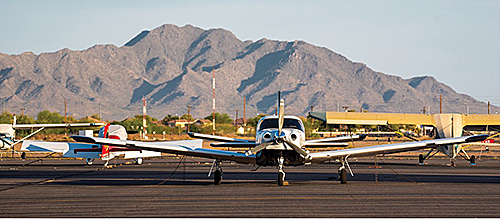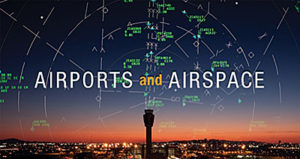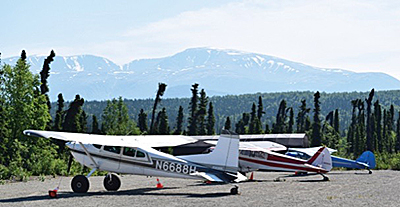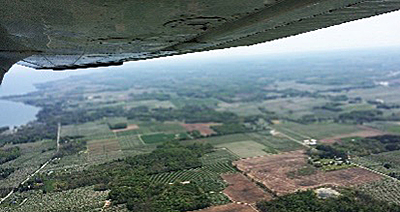The Advantages of Adventuring
Using Airport Visits to Advance Skills (and Pilot Stories!)
By Susan K. Parson, FAA Safety Briefing Editor
One of the aeronautical experience requirements for an instrument rating is to log at least 50 hours of cross-country flight time as pilot-in-command (PIC). I initially chafed because I just wanted to get on with my flight training. I also found the prospect of accumulating 50 cross-country hours a bit daunting. To make it manageable, I took a sectional chart, drew circles with 50- and 100-nautical-mile radii, and made a list of airports that landed (so to speak) in the zone.
Once I got started, I realized that many educational and proficiency benefits accrue from flying to unfamiliar airports. Though I had flown to a few during training for my private pilot certificate, most were new territory. The same was true when I participated in Virginia’s Aviation Ambassadors Program, which incentivizes visits to the state’s public-use airports.
Here are just a few of the great lessons learned from my quest.
Plans
Flight planning apps weren’t a thing yet, so I did a lot of manual flight planning. The exercise of drawing and measuring the course line, calculating performance, evaluating weather/NOTAMs, and consulting the Airport/Facility Directory (now called the Chart Supplement) for the target airport’s vital statistics solidified fundamental flight planning skills. Flying to unfamiliar airports sharpened both the competence and my confidence in pilotage, dead reckoning, and course intercepts and tracking.
Another great lesson was the experience of changing the plan for weather or operational issues that can arise. For example:
- A trip to a smaller airport on a typical summer day in the mid-Atlantic region gave me a whole new appreciation for the challenge of spotting an unfamiliar airport in thick haze. I also learned what 3-to-5-mile visibility really looks like.
- On a flight to an airport in Class C airspace, the controller abruptly canceled my landing clearance and gave me a vector to allow an airliner to zoom past. I then needed to use those ground school lessons in wake turbulence avoidance, make a last-minute runway change, and taxi through a concrete maze very different from the single-runway simplicity of my home airport.
- A scenic airport in mountainous terrain reinforced lessons about density altitude. Because its runway was also shorter than the one at home base, that airport also provided a good reminder of how important practical performance calculations are to safe operations.
People (and Pets)
One of the best benefits of venturing to different airports is meeting airport people. Like airplanes and airports, airplane people come in many shapes and sizes. The one thing they typically have in common is an outsized enthusiasm for aviation, airplanes, and fellow aviators. Friendly faces prevailed at even the bigger airports, but what fun to meet so many people whose idea of weekend fun includes hanging out at the local airport. These kind souls offer both encouragement and education on local flying conditions and quirks. I especially remember a small airport whose charmingly eccentric operator offered lunch (complete with homemade ice cream) that she served with a side of hangar flying stories to all weekend visitors.
Airport pets are special too. I’ve only met a couple of airport cats, but I’ve lost count of the number of airport dogs who offered a welcome waggin’ to itinerant pilots.
Many educational and proficiency benefits accrue from flying to unfamiliar airports.
Places
No two airports are truly the same. Larger airports with commercial service are an amazing and meticulously organized maze of pavement with multi-colored lights and signs. Smaller airports can have some of everything, which is why it pays to do some research before you launch. During the Virginia Aviation Ambassador trips, my flying companions and I experienced everything from bowl-like runways with a noticeable dip to short mountain-top strips to ski-slope runways with unidirectional takeoff and landing requirements.
Airport amenities are a pleasure as well. Though few GA airports could compete with the range of merchandise in mall-like major airports, you will find a wide range of pilot shops and, better yet, aviation-themed restaurants that contribute to an airport’s unique character. A few airports also host aviation history museums.
Airports are a great place for aviation enthusiasts to see a wide variety of aircraft types.
Planes
For those who participate in the sport of plane-spotting, what better way to feed the habit than to visit new airports? Even without a museum on site, airports are a great place for aviation enthusiasts to see a wide variety of aircraft types. I’ve stumbled upon warbirds, an astonishing variety of experimental/amateur-built planes and, best of all, old friends. I was delighted, for instance, to see the C150 that my flying club once owned on the ramp at its new home base in Delaware. I’ve sighted several of the humble but beloved birds I flew in primary training days at airports around the mid-Atlantic. Also, since learning the significance of the late 1990s-vintage C172 Skyhawks with the “ES” tail number (see “The Legacy of Echo Sierra” in the January/February 2010 issue of FAA Aviation News), I have enjoyed looking for them.
Practicing Scenario-Based Training
The bottom line: visiting airports offers aviation educational and enjoyment opportunities with the added benefit of supporting our country’s general aviation (GA) airport infrastructure. If your state has a formal airport visitation program, sign up. You can also use aviation community programs (e.g., AOPA’s Pilot Passport) to expand your horizons and engage in friendly competition with like-minded pilots.
If you are an instructor or flight school operator, an airport visitation program, whether formal or DIY, is a great way to put scenario-based training into practice. Those in states with an airport visitation program could enhance the training experience by using it for both dual and solo cross-country flights. It also offers an incentive for structured “post-graduate” flying, both for proficiency and for earning higher certificates and ratings. Your local GA airports will appreciate your support, and there is no limit to how much you can learn and enjoy in the process.
Susan K. Parson (susan.parson@faa.gov) is editor of FAA Safety Briefing and a Special Assistant in the FAA’s Flight Standards Service. She is a general aviation pilot and flight instructor.
Reprinted with permission from FAA Safety Briefing. Visit the Flight Safety Briefing website: https://www.faa.gov/news/safety_briefing/ .







